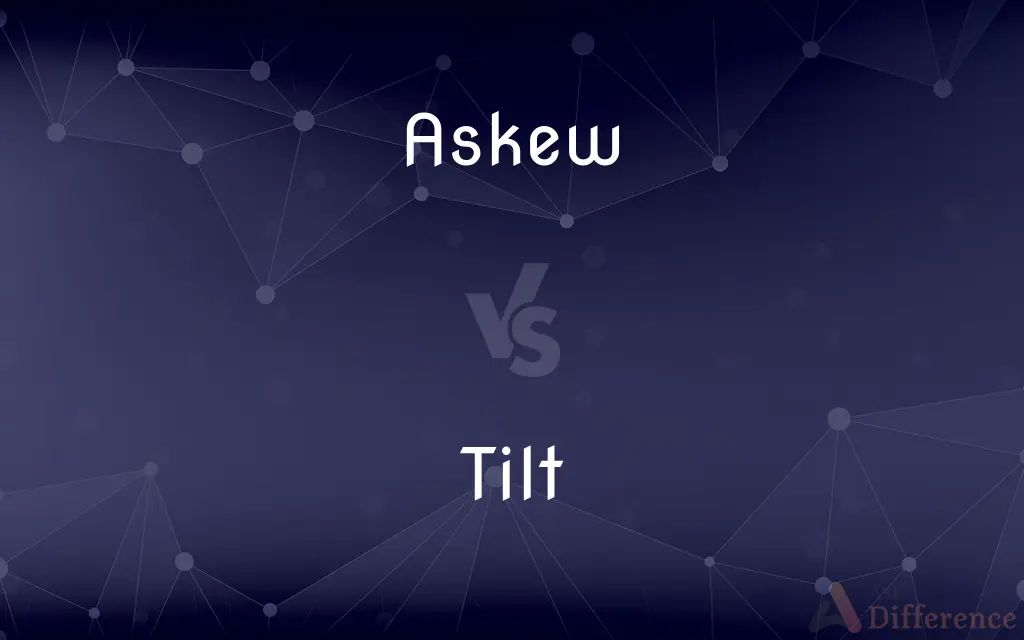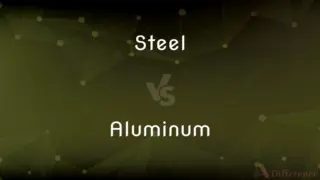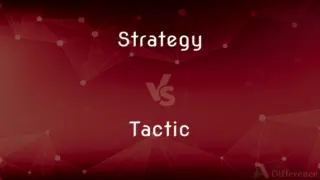Askew vs. Tilt — What's the Difference?
Edited by Tayyaba Rehman — By Maham Liaqat — Updated on March 24, 2024
"Askew" refers to something being off-center or crooked, often implying a lack of order, while "tilt" describes an intentional or natural slant or inclination from the vertical or horizontal.

Difference Between Askew and Tilt
Table of Contents
ADVERTISEMENT
Key Differences
Askew captures the essence of something being out of alignment, not straight or orderly, which can suggest an accidental or unintended misplacement. It often conveys a sense of disorder or imbalance. Tilt, on the other hand, refers to a deliberate or natural angle or inclination, suggesting movement or a stable position that deviates from the upright or a flat surface.
When something is described as askew, it often implies a need for correction or adjustment, indicating that the current state is somehow incorrect or aesthetically displeasing. Tilt does not necessarily carry this implication; it can describe a purposeful positioning, such as the tilt of a camera for a specific shot, indicating intention rather than error.
The term askew is frequently used in contexts that emphasize the visual or structural oddity, where symmetry or alignment is expected but not achieved. In contrast, tilt is used in both physical and metaphorical senses, such as the tilt of the Earth's axis or a situation being biased in favor of one side, encompassing a broader range of applications.
Askew can evoke a sense of discomfort or unease, as things that are off-balance or improperly aligned can be visually disturbing or suggest instability. Tilt, however, might suggest dynamism or a different perspective, offering a neutral or even positive connotation depending on the context.
In literature and everyday language, askew is often associated with descriptions of scenes, objects, or situations that are slightly wrong or disordered, enhancing a narrative of chaos or neglect. Tilt, conversely, is used to describe deliberate actions, perspectives, or physical states, contributing to a narrative of intentionality or strategic viewpoints.
ADVERTISEMENT
Comparison Chart
Implication
Unintentional misalignment, disorder
Intentional or natural inclination
Connotation
Disorder, need for correction
Purposeful positioning, neutrality
Usage Context
Visual oddity, misplacement
Physical/metaphorical angles or biases
Emotional Response
Discomfort, unease
Dynamism, perspective
Narrative Role
Emphasizes chaos, neglect
Suggests intention, strategy
Compare with Definitions
Askew
Suggesting something is amiss.
Her smile was askew, hinting at her discomfort.
Tilt
A mechanism of adjustment.
The pilot adjusted the tilt of the aircraft to stabilize the ascent.
Askew
Implying a need for adjustment.
The plan went askew, requiring immediate attention.
Tilt
To cause to lean, incline, slope, or slant.
She tilted her head in confusion at the question.
Askew
Associated with visual discomfort.
The asymmetrical design intentionally set elements askew to challenge perceptions.
Tilt
A strategic or creative choice.
The camera's tilt added drama to the scene.
Askew
Symbolizing disorder.
His tie was askew, reflecting the day's earlier chaos.
Tilt
Indicates a shift in balance.
The debate tilted in his favor after the compelling argument.
Askew
Not in a straight or level position.
The picture hung askew on the wall, unsettling the room's balance.
Tilt
Reflecting a particular bias.
The documentary had a tilt towards the underdog's perspective.
Askew
Askew is an English surname.
Tilt
Move or cause to move into a sloping position
The floor tilted slightly
He tilted his head to one side
Askew
Not in a straight or level position
Her hat was slightly askew
Tilt
(in jousting) thrust at with a lance or other weapon
The lonely hero tilting at the system
He tilts at his prey
Askew
To one side or out of proper alignment; awry
Rugs lying askew.
Tilt
A sloping position or movement
The tilt of her head
Askew
Turned or twisted to one side.
Tilt
A combat for exercise or sport between two men on horseback with lances; a joust.
Askew
(figuratively) Untoward, unfavourable.
Tilt
A small hut in a forest.
Askew
Tilted to one side.
He wore his hat askew
Tilt
To cause to slope, as by raising one end; incline
Tilt a soup bowl.
Tilt a chair backward.
Askew
Awry; askance; asquint; oblique or obliquely; - sometimes indicating scorn, or contempt, or entry.
Tilt
To cause to be advantageous to one party rather than another
A development that tilted the balance of trade in their favor.
Askew
Turned or twisted toward one side;
A...youth with a gorgeous red necktie all awry
His wig was, as the British say, skew-whiff
Tilt
To aim or thrust (a lance) in a joust.
Askew
Turned or twisted to one side;
Rugs lying askew
With his necktie twisted awry
Tilt
To charge (an opponent); attack.
Tilt
To forge with a tilt hammer.
Tilt
To slope; incline
The field tilts toward the river.
Tilt
To have a preference, favor, or be inclined toward something
She recently tilted toward vegetarianism.
Tilt
To be advantageous to one side over another, as in a dispute
"The battle ... was beginning to tilt again in the Confederates' favor" (Stephen W. Sears).
Tilt
To fight with lances; joust.
Tilt
To engage in a combat or struggle; fight
Tilting at injustices.
Tilt
To cover (a vehicle) with a canopy or an awning.
Tilt
The act of tilting or the condition of being tilted.
Tilt
An inclination from the horizontal or vertical; a slant
Adjusting the tilt of a writing table.
Tilt
A sloping surface, as of the ground.
Tilt
A tendency to favor one side in a dispute
The court's tilt toward conservative rulings.
Tilt
A preference, inclination, or bias
"pitilessly illuminates the inaccuracies and tilts of the press" (Nat Hentoff).
Tilt
A medieval sport in which two mounted knights with lances charged together and attempted to unhorse one another.
Tilt
A thrust or blow with a lance.
Tilt
A combat, especially a verbal one; a debate.
Tilt
A tilt hammer.
Tilt
New England See seesaw.
Tilt
A canopy or an awning for a boat, wagon, or cart.
Tilt
(transitive) To slope or incline (something); to slant.
Tilt the barrel to pour out its contents.
Tilt
(intransitive) To be at an angle.
Tilt
To charge (at someone) with a lance.
Tilt
(transitive) To point or thrust a weapon at.
Tilt
(transitive) To point or thrust (a weapon).
Tilt
To forge (something) with a tilt hammer.
To tilt steel in order to render it more ductile
Tilt
To intentionally let the ball fall down to the drain by disabling flippers and most targets, done as a punishment to the player when the machine is nudged too violently or frequently.
Tilt
To play worse than usual (often as a result of previous bad luck or losses).
Tilt
(transitive) To cover with a tilt, or awning.
Tilt
A slope or inclination.
Tilt
The inclination of part of the body, such as backbone, pelvis, head, etc.
Tilt
(photography) The controlled vertical movement of a camera, or a device to achieve this.
Tilt
A jousting contest. (countable)
Tilt
An attempt at something, such as a tilt at public office.
Tilt
A thrust, as with a lance.
Tilt
A tilt hammer.
Tilt
A canvas covering for carts, boats, etc.
Tilt
Any covering overhead; especially, a tent.
Tilt
A covering overhead; especially, a tent.
Tilt
The cloth covering of a cart or a wagon.
Tilt
A cloth cover of a boat; a small canopy or awning extended over the sternsheets of a boat.
Tilt
A thrust, as with a lance.
Tilt
A military exercise on horseback, in which the combatants attacked each other with lances; a tournament.
Tilt
See Tilt hammer, in the Vocabulary.
Tilt
Inclination forward; as, the tilt of a cask.
Tilt
To cover with a tilt, or awning.
Tilt
To incline; to tip; to raise one end of for discharging liquor; as, to tilt a barrel.
Tilt
To point or thrust, as a lance.
Sons against fathers tilt the fatal lance.
Tilt
To point or thrust a weapon at.
Tilt
To hammer or forge with a tilt hammer; as, to tilt steel in order to render it more ductile.
Tilt
To lean; to fall partly over; to tip.
The trunk of the body is kept from tilting forward by the muscles of the back.
Tilt
A combat between two mounted knights tilting against each other with blunted lances
Tilt
A contentious speech act; a dispute where there is strong disagreement;
They were involved in a violent argument
Tilt
A slight but noticeable partiality;
The court's tilt toward conservative rulings
Tilt
The property possessed by a line or surface that departs from the vertical;
The tower had a pronounced tilt
The ship developed a list to starboard
He walked with a heavy inclination to the right
Tilt
Pitching dangerously to one side
Tilt
To incline or bend from a vertical position;
She leaned over the banister
Tilt
Heel over;
The tower is tilting
The ceiling is slanting
Tilt
Move sideways or in an unsteady way;
The ship careened out of control
Tilt
Charge with a tilt
Common Curiosities
How do you correct something that's askew?
By adjusting it to be straight or properly aligned.
What does it mean for a picture to hang askew?
It means the picture is not hanging straight or level on the wall.
Can tilt be a positive thing?
Yes, tilt can be positive, indicating a purposeful inclination or strategy.
Can the earth tilt?
Yes, the Earth has a tilt on its axis, which is a natural inclination affecting seasons.
What's the difference between tilting a container and something being askew?
Tilting a container is a deliberate act to pour its contents, while something being askew implies unintentional misalignment.
Is askew always negative?
Often, but not always. It implies disorder or misalignment, which can be undesirable or used artistically.
Is askew used only in physical contexts?
Primarily, but it can also describe abstract situations where there's a deviation from the norm.
What does a tilt in perspective mean?
It means adopting a particular viewpoint or bias, often intentionally.
What does it mean if negotiations went askew?
It means they did not go as planned and were possibly disrupted or derailed.
How do you use tilt in photography?
By angling the camera to achieve a specific composition or effect.
Is tilting always intentional?
Mostly, though natural phenomena like the Earth's tilt are not due to human intention.
Can a building be both askew and tilted?
Yes, if it's unintentionally misaligned (askew) and also designed or ended up inclined (tilt).
How does tilt contribute to storytelling in film?
It can create tension, signify a character's imbalance, or offer a unique perspective to engage the audience.
Does askew imply a problem to be fixed?
Often, yes, as it suggests something is not in its correct or desired position.
Can a person's opinion be askew?
Yes, in the sense that it might deviate from what's commonly accepted or expected.
Share Your Discovery

Previous Comparison
Steel vs. Aluminum
Next Comparison
Strategy vs. TacticAuthor Spotlight
Written by
Maham LiaqatEdited by
Tayyaba RehmanTayyaba Rehman is a distinguished writer, currently serving as a primary contributor to askdifference.com. As a researcher in semantics and etymology, Tayyaba's passion for the complexity of languages and their distinctions has found a perfect home on the platform. Tayyaba delves into the intricacies of language, distinguishing between commonly confused words and phrases, thereby providing clarity for readers worldwide.
















































